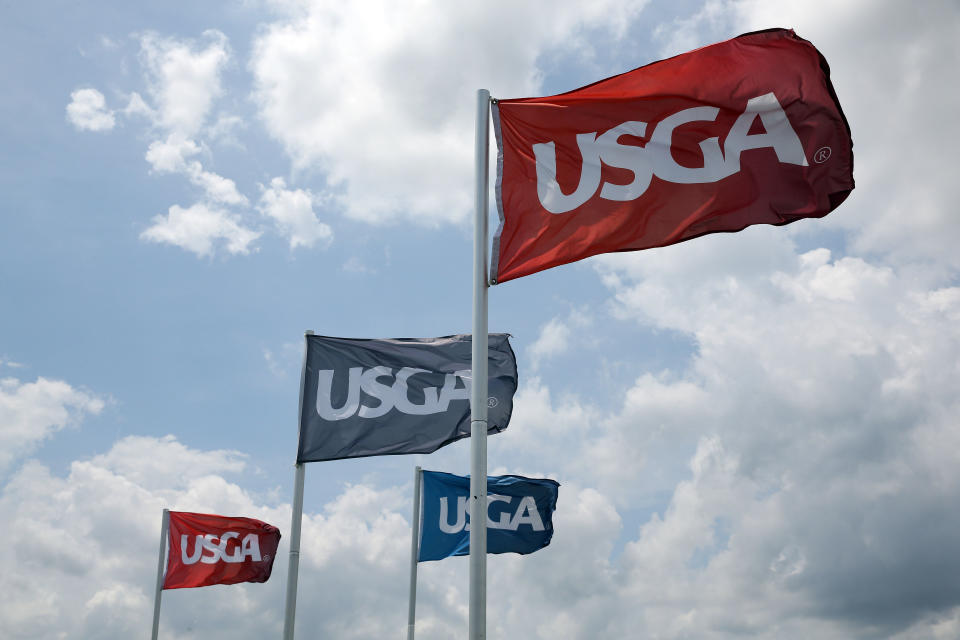From the return of longtime broadcast voices to a ‘firm and fast’ test, here’s what to expect from the 2024 U.S. Open at Pinehurst

PINEHURST, N.C. — For many years, the United States Golf Association struggled with the idea of whether a U.S. Open could work at Pinehurst. There were questions about the distance from a major city like Raleigh or Charlotte. Would fans make the trip? How much corporate support could be gathered? Not to mention the agronomics.
In 1999 and 2005, those questions were put to bed as the Cradle of American Golf showed it was worthy and capable of hosting the national open. In 2014 the resort even proved it could host back-to-back majors with both the men’s and women’s U.S. Opens in consecutive weeks.
Next month, the USGA’s flagship championship will return to the Sandhills of North Carolina, June 13-16, for not just the first time in 10 years, but for the first time as an anchor site. Back in 2020, the USGA announced plans to build Golf House Pinehurst less than a par 5 away from the main clubhouse, as well as host five future U.S. Opens at Pinehurst No. 2 in 2024, 2029, 2035, 2041, and 2047. As if this year’s U.S. Open wasn’t special enough for the governing body, the 2024 event will be the USGA’s 1,000th championship.
At the U.S. Open media day held at Pinehurst last week, USGA President Fred Perpall said the new buildings on campus at Pinehurst are “a physical manifestation of a relationship that we hope will last forever.” The USGA has built a new equipment-testing facility, innovation hub, museum and visitors center, as well as an office for 70 of its staff.
Here’s what we learned from the media day with regard to what fans can expect from the 2024 U.S. Open and beyond.

USGA flags flap in the wind during a practice round of the U.S. Open golf tournament at Erin Hills. Mandatory Credit: Rob Schumacher-USA TODAY Sports
Importance of anchor sites
From an outside perspective, it’s a little weird that the USGA has planned out its future U.S. Open host sites until 2051. Chief Championships Officer John Bodenhamer would argue it’s important for the growth of the championship to establish anchor sites like Pinehurst, Oakmont and Pebble Beach in order to continuously improve and not take any steps back.
“We can do so much because we know we’re coming back,” he said. “Golf House Pinehurst and that dream is becoming a reality.”
In addition to the two new buildings that will entertain and teach fans about the history of the game and governing body, the championship has become more sustainable, as well. With its investment in Pinehurst, the USGA has eliminated diesel generators and more than 50,000 gallons of diesel fuel won’t be used due to powerlines underground. New underground waterlines will aid concessions and hospitality venues. It’s all subsurface and additive and spectators will be none the wiser.
“I will tell you that anchor sites come from some mistakes of the past too,” added USGA CEO Mike Whan. The USGA would go to a place like Pinehurst in 1999 or 2014 for the championship, then come back 30 days later for a debrief to talk about what they wish they would’ve done or what could’ve been improved.
“Then we’d come back in 20 years and go, ‘How about if we …’ and nobody that did the last (championship) are there and nobody invested in all those things because they didn’t know we were coming back and we didn’t know,” Whan continued. “So to say to Pinehurst, what if we came back this regularly? Or if Merion knew we were coming back or Pebble Beach didn’t guess if we were coming back in eight years or never coming back. What together would we do to make the championship bigger, better, stronger?”
On top of the sustainability developments, a new championship locker room with a tunnel directly to the first tee has been built beneath the clubhouse.
“So those are kind of things I don’t know that we would invest in. Would we have built a headquarters across the street at a place we weren’t coming back to? Probably not,” said Whan. “We’re investing in our anchor sites and so are they and that makes the long-term excitement of those sites even better.”

Pinehurst No. 2 in North Carolina (Courtesy of Pinehurst Resort)
Over the next 25 years, the USGA will host a championship at Pinehurst every three years, including the four previously mentioned U.S. Opens. The resort will host the 2027 U.S. Women’s Amateur, 2032 U.S. Junior Amateur and U.S. Girls’ Junior, 2038 U.S. Amateur, 2044 U.S. Women’s Amateur and a future U.S. Adaptive Open.
Golf House Pinehurst opens
Golf House Pinehurst officially opened on Friday, May 10, which includes the USGA’s equipment-testing and research facility, the USGA Experience, an outdoor educational landscape feature, the relocated World Golf Hall of Fame and administrative offices for 70 staff members.
According to the USGA, independent studies estimate the total economic impact of the USGA’s long-term presence in Pinehurst, combined with the USGA championships it will bring as an anchor site, will exceed $2 billion to the state of North Carolina.
The USGA Experience and World Golf Hall of Fame will be open from 10 a.m. ET to 5 p.m. ET Wednesday through Sunday, with extended hours until 8 p.m. ET on Thursdays. Admission is free through the month of June. The Hall of Fame features 170 player lockers with more than 3,000 artifacts on display.
Broadcast plans and digital innovations
Chief Commercial Officer Jon Podany and his team don’t have the same challenges at Pinehurst that a venue like Los Angeles Country Club or the Country Club presented. The USGA feels like this is a home game to showcase their product on their new home turf, and they’ve amplified coverage across the board. First up, let’s take a look at TV and streaming.
“Looking back at 2022 when we were at the Country Club on the East Coast, there was a lot of switching back and forth across NBC, USA and Peacock,” said Podany. “What we’re doing for this year is to simplify that for fans so there’s basically only two networks per day, with one variation on Friday just to get that bonus coverage on Peacock.”
Early round coverage switched to USA from Golf Channel a few years ago because USA has 16 million more households than Golf Channel, which gives the championship a wider reach. There will be more hours of linear coverage than any other major at the U.S. Open, including 47 hours across NBC, USA and Peacock, with another 36 hours of coverage of Live From on Golf Channel and Peacock. NBC’s full talent roster will be involved, including the addition of Roger Maltbie and Gary Kock for all four days. The longtime voices were added to coverage after their successful returns to the Players Championship broadcast earlier this year. Now that he’s off Justin Thomas’ bag, Jim “Bones” Mackay will also return as an on-course reporter.

Golf Channel commentator Jim “Bones” Mackay looks on during the final round of the 2023 Honda Classic at PGA National Champion course in Palm Beach Gardens, Florida. (Photo: Jared C. Tilton/Getty Images)
“The expanded number of options for how fans can view the championship, whether that’s the main television screen or second screen on digital, our web and app offerings, you can really follow every shot by every player in a lot of different ways,” explained Podany. “I think fans will enjoy that.”
With golf, the commercial load on broadcasts is always a topic of discussion. Podany said the USGA and NBC are working together to reduce the number of interruptions on broadcasts over the four days.
“We did take steps in the early round coverage last year, and we will be taking those steps on USA, whether that’s the number of promotions we have from the USGA standpoint, NBC’s promotions, commercial interruptions, the number of breaks we take, we are looking at all that to try to present the telecast to the viewers in the best way possible,” said Podany, who also noted that NBC will make the Sky Sports feed available on Peacock (Sky has far less in-action interruptions). The final hour on Sunday will once again be commercial-free thanks to Rolex.
“It’s a balancing act, obviously, because for us and for our broadcast partners it’s gotta make financial sense, so we need commercials within the broadcast,” explained Podany. “Honestly if you look at the breaks per hour on a golf tournament, it’s better than the NFL, college football, NBA. The difference is we don’t have timeouts and natural breaks, coverage is still going on. There has to be a little bit of acceptance of that but we’re trying to improve it as best we can.”
The USGA wanted to provide as many options as possible for fans to take in the U.S. Open, so there will be three featured groups on the digital stream as well as the return of All-Access on Peacock, a RedZone-type channel that will air live highlights on Thursday and Friday.
On-course conditions will be ‘firm and fast’
The U.S. Open is known for being the toughest test in golf with long courses, narrow fairways and heavy rough. The challenge posed to players at this year’s championship will be slightly different. In lieu of long rough will be thousands of wire grass plants in sandy native areas that will make shot execution as much of a mental test as a physical one.
“With Pinehurst No. 2 we feel that the golf course is always close to U.S. Open ready,” said Tom Pashley, the President of Pinehurst Resort. “We don’t have to grow up the rough, we don’t have to narrow the fairways. We focus on firming up the conditions and making sure it’s fast. Now with Bermuda grass greens instead of Bent grass greens, we can’t wait to see how the Donald Ross greens perform under U.S. Open conditions.”

The fifth hole at Pinehurst No. 2 in Pinehurst, North Carolina. (Photo: Fred Vuich/USGA)
Aside from the Bermuda grass, not much will be different from the 2014 U.S. Open. The only other material change will show on the par-4 13th hole, where the fairway was narrowed by 12 yards. The landing area on the 381-yard hole will be around 28 yards wide.
As a whole, No. 2 will play to 7,540 yards from the back tees with a par of 70. The distance is flexible from 7,300-7,500 yards depending on the weather and wind. Putting greens will be rolling 13 plus on the Stimpmeter and the course will be quick, firm and fast.
“We’re known for toughness, and you’ll see it right here on No. 2 in just a few days. But a lot of people have a misconception about tough but fair,” Bodenhamer explained. “It does not mean that our goal is for the winner to shoot even par, but it does mean that we want that winner to get every club in his bag dirty when he wins a U.S. Open, including the club between the ears.”
“We want to test every part of their game. We want them to hit it high, low, left to right, right to left. We want them to think about their golf ball. What happens to when it hits the ground, not just in the air,” he added. “We don’t come in and put a cookie-cutter USGA approach on these great golf courses. We stay true to what Donald Ross intended and the great architects of these great vigils intended.”
“We want players to be able to control the golf ball on the ground, not just in the air.”
With all that said, is it June yet?

